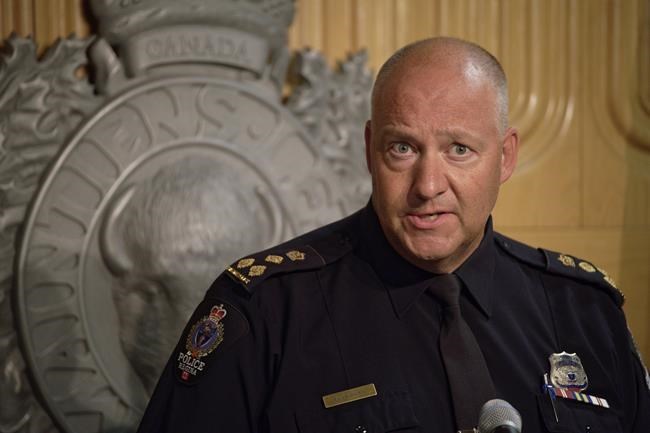A report of a suspect vehicle in Saskatchewan's capital hours after a stabbing rampage on a First Nation some 300 kilometres away suddenly pulled city officers into the investigation and kept residents on edge for days.
The sighting “swiftly brought us into the unexpected storm," Regina police Chief Evan Bray would later say in an email to the police service.
Emails obtained by The Canadian Press under freedom of information laws give some insight into how Regina police responded following the stabbings on Sept. 4, which left 11 dead and 18 injured on the James Smith Cree Nation and in the nearby village of Weldon, Sask.
The suspect in the attacks, 32-year-old Myles Sanderson, died in police custody Sept. 7. Police have not confirmed whether he was in Regina during his time on the run.
A truck he was suspected of driving after the killings was found in the small community of Crystal Springs, 65 kilometres southwest of the First Nation. Sanderson was eventually spotted outside a home in nearby Wakaw, leading to a highway chase and his arrest.
But a sense of unease washed over Regina during the manhunt and city police brought in extra resources.
The stabbings began early on the Sunday morning on the First Nation, about 170 kilometres northeast of Saskatoon. Four dangerous persons alerts were released before 10 a.m. saying there had been multiple victims and giving descriptions of the suspects and the vehicle in which they were believed to be travelling.
Just before 10:30 a.m., emails show RCMP Criminal Intelligence Service Saskatchewan Director Chris Lane contacted Regina police about "possible connections in the city."
Just after noon, Mounties issued a fifth alert saying there were reports of the suspect vehicle in Regina. Residents were asked to stay inside and the Saskatchewan Roughriders added extra security for the Labour Day Classic football game that evening.
Emails show about 40 Regina police employees were part of the response, including detectives and additional patrol officers.
Bray became one of the official faces of the response to the killings, joining Mounties for press conferences and posting videos on social media.
Early on Sept. 5, Bray posted on social media that the suspects remained at large, despite “ongoing, relentless” efforts of officers overnight.
Police across the province had initially been looking for Myles Sanderson and his brother, Damien Sanderson. Later on Sept. 5, Damien Sanderson was found dead on the First Nation.
The next day, emails show Regina’s police chief had information that Myles Sanderson was not in the city.
“Can you give me a sense of the ability to communicate the fact we believe he may no longer be in Regina? Is that something we can say?” Bray wrote in an email on the morning of Sept. 6.
The redacted correspondence does not explain what that information was. But the emails show a superintendent saying the police chief should not release that information as there was "no visual on subject."
Later that afternoon, however, Bray went against that advice and posted a video on social media saying, “we’ve received information that is leading us to believe he may no longer be in this community.”
Regina police declined an interview request to have Bray explain what happened in the hours between the emails and the social media post, stating it was an RCMP-led investigation and that the chief would not do interviews before Saskatchewan's chief coroner completes aninquest ordered into the stabbings.
An email from Regina police Supt. Trent Stevely did lay out a briefing with RCMP on the morning of Sept. 6, saying officers were "planning extensive ground and aerial searches today in the north."
The following day, a 911 call came in about a break-and-enter in the town of Wakaw, about 110 kilometres southwest of the First Nation. Police vehicles sped down rural roads in the area and a helicopter hovered overhead.
A white truck hit a ditch and drove into trees along the highway near Rosthern. Myles Sanderson was taken into police custody. He went into medical distress shortly after and died.
The work did not end for police. Emails detail weeks of ongoing questions from reporters and government officials, looking for explanations about what happened in Regina.
In an email to staff the morning after Myles Sanderson was found, Bray said the threat may be gone but the investigative work and questions would go on for some time.
“You answered a call of duty from our RCMP partners, our province and our city,” Bray wrote.
“You were professional, respectful and tenacious in your work and I know took care of one another through the process.”
This report by The Canadian Press was first published Jan. 11, 2023.
Kelly Geraldine Malone, The Canadian Press



